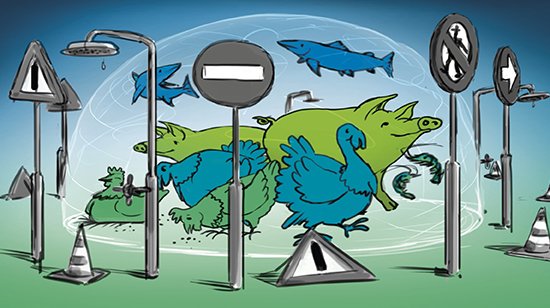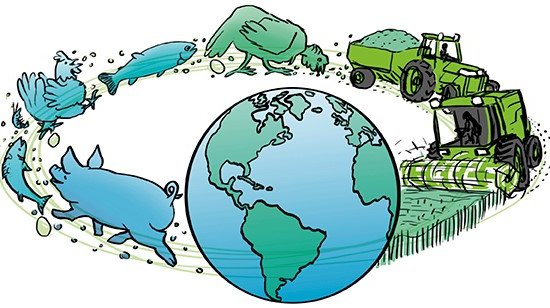
Published on July 30, 2021
Stepping towards economic sustainability
As part of the animal protein value chain, market volatility, disease outbreaks, and supply-demand inequalities are all issues that keep us up at night. At the end of the day, we all want to find better efficiencies in the system so that we can get the full value of our efforts.
Along with social and environmental sustainability, economic sustainability is the key to solving inefficiencies and volatility in the industry. Genetics can offer one piece of the solution by providing reliable, healthy animals that deliver predictable results. But there are many other areas of opportunity to discover together.
Let’s examine the roadblocks to economic sustainability and the pathways to a better future where producers and consumers can rely on affordable, high-quality animal protein.
The pressures of economic uncertainty
Margin pressure is intense for those in the animal protein industry. Risks such as disease outbreaks, lack of experienced labor, and market volatility can quickly change an operation from profitable to dealing with disastrous losses. How can we find a better balance and escape the constant pressure to deliver profits in the face of extreme challenges? In this article, we explore three solutions for better economic sustainability
- Placing the right genetics in the right environment
- Strong biosecurity for reliable supply
- Better efficiency through new innovations
One important factor is finding the right genetics for the right environment. If parent stock animals are selected in a completely different environment than their offspring, it’s difficult to predict their performance. A chicken raised in a highly biosecure facility that’s perfectly climate controlled will not necessarily behave the same way as a chicken raised in an outdoor, sub-Saharan African farm. Performance testing of siblings or offspring in the environment that the offspring is supposed to perform is necessary to be able to offer the right genetics.
The SAPPSA (Sustainable Access to Poultry Parent Stock to Africa) project is an example of making sure the right genetics are in the right environment. This important project was initiated to give rural African farmers access to tailored breeds that perform well according to the local needs and environmental pressures of the region. With birds that are suited for the African market and environment, performance will be more reliable, delivering a good profit for the smallholder farmer.
We still have so much to gain to enable every individual producer to have the right animal for their system. The right genetics reduces losses, improves productivity, and increases the bottom-line result.
Biosecurity for trusted reliability
How can producers take the first steps in minimizing the pressure to deliver profits? Balanced and biosecure genetics can address many of the challenges in realizing economic gains. Reliable, biosecure animals in a global network is one way of preserving an economically sustainable system.
We produce and distribute different species all over the world. To ensure continuity and prevent transmission of disease agents, we maintain a high health status. Utilizing global standardized biosecurity protocols, we ensure clean stock is our standard when delivering to all of our customers. Beginning at the start of the protein value chain, we must assure that the health status of all breeding stock meets the highest requirements. Through rigorous testing and specific biosecurity measures we ensure that our animals are maintained in secured, controlled environments. Our global network of biosecure facilities also allows us to deliver products to our customers, even in the event of trade barriers due to disease outbreak.
Our grandparent laying hen farms and hatcheries in Brazil and the Netherlands are leading by example and have been awarded AI Free compartment status, granted by World Organization for Animal Health (OIE). This status allows us the ability to ship to customers all over the world and keeps the value chain moving consistently.
How can we go further?
Strong biosecurity and reliable genetics are important tools in creating a more economically sustainable food system, but how can we find new opportunities and go to the next level? Technological advancements have already given us better efficiencies leading to more economic stability. But there is more out there to discover. In our role as the start of the value chain, we are actively working to find these new areas of opportunity.
With gene editing, it is possible to cut and paste at specific locations within the DNA with such accuracy that repairing genetic defects or eliminating certain traits becomes feasible. This could be an important breakthrough within genetics, and as a result, a spectacular revolution for breeding animal protein. Especially when you take into consideration that when applied in a very early stage, changes made within the DNA is passed on to offspring. Gene editing offers the opportunity for enhanced efficiency. If we can make faster, more accurate breeding decisions, we can take animal performance to the next level. Although gene editing is a rapidly developing technology, it is still in its infancy. Hendrix Genetics does not currently use any form of gene editing or genetic modification.
Investment in research into gene editing does not imply that Hendrix Genetics will necessarily use this technology in the future. Before using a new technology, we need to understand the full impact of it on animals, animal products and humans. We must be convinced of the added value of gene editing before entering any discussion on commercial application. Such discussion will not only cover technical issues but more important ethical and regulatory issues. At the moment, Hendrix Genetics sees several critical challenges ahead for gene editing that must be resolved before commercial application can even be considered. We are passionately driven to achieve global leadership in animal genetics, and we will continue to closely monitor the rapid developments in this new technology to evaluate its potential application.
A stable and sustainable economic system is important for the future of our industry. A secure supply of healthy animal genetics, selected for the right environment, is one piece of the puzzle. Only through collaboration and transparency can we find an overarching solution. The result will be more reliable, affordable animal protein that can feed our growing world.



